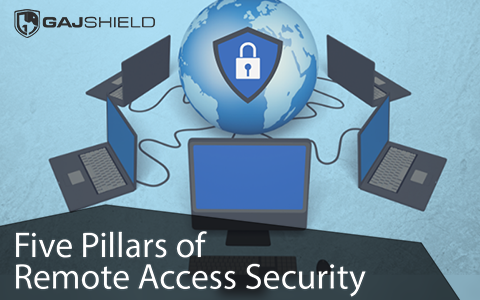5 pillars of remote access security
The relevance of working remotely instead of being at the workplace has never been greater than now. As you may know, several companies around the world have operated during the pandemic with employees performing their jobs from home. While this is a convenient mode of working, the number of cyber-security threats have also risen in recent years. One problem of remote work operations is that an organisation’s cybersecurity frameworks are not available when employees are working from home.

This can especially be a major problem while managing Identity and Access Management (IAM) for the organisation’s data network. Therefore, it becomes essential for cyber-security experts to emerge with intelligent solutions to resolve problems related to remote access management. Among other points, the six most important aspects of remote access security are:
Using contextually-aware access security systems
Remote context-based data security is an upgrade over standard Multi-Factor Authentication (MFA) systems. A practical example of a contextually aware access system is a student taking an examination. The right candidate needs to reach the examination centre at a specified time while possessing the hall ticket to take the test. Similarly, a context-based system requires the right users to input the correct login credentials at a designated time for an appropriate reason and at an exact location (if the location is applicable) before it permits them the access into a company network.
Context-aware extensions to ensure remote access safety can help an organisation to maintain steady levels of IAM for employees and users in distant locations. The application of this technology can be remotely achieved with the help of virtual firewalls and cloud-data security systems.
Deploying intelligent firewalls to regulate user access
Intelligent firewalls help to secure remote networks against unauthorised user access by using intelligent threat-sensing measures. Such firewalls serve many purposes to stop cyber-threats from remotely accessing and damaging the centralised data belonging to organisations. Intelligent firewalls play a part in protecting browsers and operating systems against malicious code. As a result, viruses and malware can be screened out during website visits and file downloads through a browser. Intelligent firewalls offer a certain degree of user behavioural monitoring to stop suspicious activities from occurring in regular and cloud networks. Such systems have powerful detection engines to simply block potential cyber-attackers from accessing an employee’s device during their work operations.
Intelligent firewalls contain several predefined commands and details about known threats in their protocols. To successfully contain remote threats, such firewalls filter them out from the network traffic while also updating its records consistently to deal with newer threats detected in the company network. Thus, intelligent firewalls are equally effective in managing remote and regular access threats to a network.
Safeguarding end-to-end company network access
In a remote working environment, access management can be made more secure by deploying the following measures for end-to-end access safeguarding:
- Creating a remote cybersecurity policy initially
- Regularly updating user passwords
- Using MFA systems with context-aware settings
- Using data encryption application software at both ends
- Usage of firewalls and reputed antivirus software
- Backing up online data at a secure digital location by users
Carrying out Network Traffic Analysis (NTA)
Company operations away from the workplace occur on the data network of the organisation. Therefore, traffic analysis is a good option to detect malware, viruses, or unauthorised persons in the network. Such analyses are useful to proactively manage access controls of the organisation. NTA helps to remotely regulate security controls by studying user behaviour over a period in the data network.
The analysis understands normal user behaviour in the company network. It notifies the employee’s organisation on detecting anomalous behaviour during the analysis. By informing the cyber-security team about likely access breaches, NTA can provide data security to mitigate a potential cyber-attack.
Implementing cloud-based remote access security
This is a cloud-based data security service to disallow unauthorised users from accessing an organisation’s data network. This technology allows companies to remotely manage actions, such as adding or revoking user access, without needing hardware input. One of the main advantages of cloud-based access management systems compared to traditional cyber-security systems is their cost-efficiency. Cloud-based systems do not need massive budgets to be allocated for setting up their infrastructure. Network administrators supervise and regulate the cyber-security restrictions and allowances in cloud-based access management systems.
Behavioural analytics and User and Entity Behaviour Analytics (UEBA)
User and Entity Behaviour Analytics (UEBA) in advanced data security systems can remotely monitor human behavioural patterns daily to detect anomalies. The systems monitor every detail, such as an employee’s login and logout times. Over a sustained period, such anomalies can lead to network threats and harmful breaches of sensitive company data. However, behavioural analytics are effective tools to pre-empt and notify administrators about potential cyber-threats in the network.
Newer UEBA-enabled systems apply machine learning, which quickens the process of identifying and analysing user behaviour patterns in a more comprehensive way. Machine learning greatly boosts the performance of data security systems regarding protecting against harmful activities. It helps cyber-security experts scan through vast amounts of data to identify suspicious activities and deliver appropriate results. Behavioural analytics is an inseparable part of modern IAM systems and frameworks.
In these strange times, companies need to be adaptive to be in control of their confidential data. As we have seen, most of these above-mentioned ‘pillars’ are easily obtainable for an organisation to function properly even with the employees working from home. Gajshield offers advanced data security solutions for organisations and individuals looking for newer data security technologies or trends. You can contact us to get valuable insights about remote working as well as our data security products and services for your organisation.
Get In Touch With Us
Subscribe to our Newsletter
2025 © GajShield Infotech (I) Pvt. Ltd. All rights reserved.
